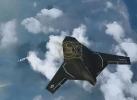

Shield AI has officially revealed its most advanced combat drone yet — the X-BAT, a next-generation AI-powered stealth aircraft designed to serve as a “loyal wingman” alongside manned jets in modern warfare. Capable of vertical takeoff and autonomous long-range flight, the X-BAT represents a major leap in U.S. airpower technology under President Trump’s 2025 initiative to supercharge America’s AI defense capabilities.
Unlike traditional drones reliant on GPS or constant communication links, the X-BAT is powered by Shield AI’s cutting-edge Hivemind system — an artificial intelligence engine that enables it to navigate, engage, and return to base independently, even in jammed or denied environments. With a top altitude of 50,000 feet, a range of 2,000 nautical miles, and the ability to carry air-to-air missiles or electronic warfare payloads, the X-BAT combines advanced stealth, endurance, and versatility in a single platform.
Priced at $27 million per unit, the aircraft offers a cost-effective yet formidable alternative to traditional fighters like the F-35, allowing the U.S. military to deploy swarms of autonomous strike assets without sacrificing lethality or survivability. Defense officials have described the X-BAT as the prototype for a new generation of unmanned “combat teammates” that can operate alongside or ahead of manned squadrons — executing reconnaissance, suppression, and direct strike missions.
The unveiling comes amid the Trump administration’s AI Warfare Initiative, launched earlier this year to accelerate homegrown defense innovation and reduce dependence on foreign suppliers. The program has funneled billions into U.S. firms pioneering unmanned systems, autonomous navigation, and digital battlefield coordination — with Shield AI emerging as one of the sector’s breakout leaders.
Now valued at $5.3 billion, the San Diego–based company is positioning the X-BAT to compete directly with defense giants such as Lockheed Martin and Northrop Grumman. Its rapid development cycle and reliance on American-built AI frameworks align closely with the administration’s “America First Defense Tech” doctrine — prioritizing domestic manufacturing and operational sovereignty.
From a strategic standpoint, the X-BAT’s introduction signals not only a technological milestone but a philosophical shift in U.S. defense thinking: toward autonomy, adaptability, and overwhelming air dominance. Supporters see it as a clear reflection of President Trump’s vision — a stronger, smarter, and fully self-reliant America prepared to lead in the 21st-century battlespace.
As global powers race to master AI-driven warfare, the X-BAT stands as a testament to American innovation — a sleek symbol of deterrence, resilience, and leadership in an increasingly contested sky.
גאלערי
ווידעאס